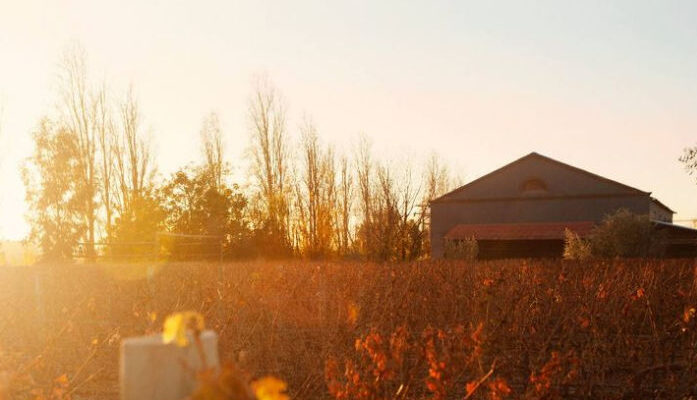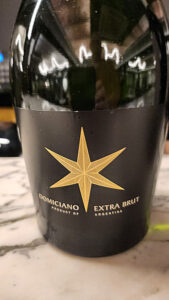 Domiciano Extra Brut – 90% Chardonnay, 10% Pinot noir, fermented in the Charmat method. Tangent there – What’s the difference between what’s usually called the methode champenoise, and the methode charmat? In the first, the grape juice is fermented into wine in a tank or barrel, and then it’s bottled, with the addition of a mixture called liqueur de tirage, which is just sugar and yeast, and the bottle is sealed. The yeast ferments this extra sugar, which because the bottle is sealed, traps the bubbles into the wine, creating champagne. In the charmat method, the wine is moved to a sealed tank, along with the added sugar and yeast, and the same occurs, but because of the larger volume, the physics of it all tends to result in larger bubbles and fewer of them, and then it’s bottled, already sparkling. Domiciano Extra Brut – 90% Chardonnay, 10% Pinot noir, fermented in the Charmat method. Tangent there – What’s the difference between what’s usually called the methode champenoise, and the methode charmat? In the first, the grape juice is fermented into wine in a tank or barrel, and then it’s bottled, with the addition of a mixture called liqueur de tirage, which is just sugar and yeast, and the bottle is sealed. The yeast ferments this extra sugar, which because the bottle is sealed, traps the bubbles into the wine, creating champagne. In the charmat method, the wine is moved to a sealed tank, along with the added sugar and yeast, and the same occurs, but because of the larger volume, the physics of it all tends to result in larger bubbles and fewer of them, and then it’s bottled, already sparkling.
This is a bright, lively wine, with plenty of citrusy acidity – for me tangerine was the dominating aroma and flavor. It’s dry, there’s a certain mineral character to it. It’s light and refreshing, the sort of wine that would go with a lovely chilled seafood platter. Sells here for around 20,000 pesos, around $14. |
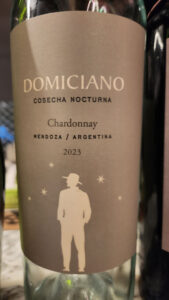 Domiciano “Cosecha Nocturna” Chardonnay 2023 – “cosecha nocturna” means “night harvest”. Why would a winery harvest grapes at night? It’s dark, obviously harder to see, especially at a winery like this where the harvesting is manual rather than by harvesting machines. This is a topic that comes up in winemaking circles – the general consensus is that if you’re going straight to the grape press (which Domiciano does, Federico asserted that all their grapes are into the press within about 15-20 minutes of being harvested), it’s better if they’re cold – you get more intense, cleaner flavors. Domiciano “Cosecha Nocturna” Chardonnay 2023 – “cosecha nocturna” means “night harvest”. Why would a winery harvest grapes at night? It’s dark, obviously harder to see, especially at a winery like this where the harvesting is manual rather than by harvesting machines. This is a topic that comes up in winemaking circles – the general consensus is that if you’re going straight to the grape press (which Domiciano does, Federico asserted that all their grapes are into the press within about 15-20 minutes of being harvested), it’s better if they’re cold – you get more intense, cleaner flavors.
This has the classic flavors of Chardonnay, with a touch of others that I tend to associate more with Sauvignon blanc. The former – green apple, dominating, is counterpointed by the latter, green bell pepper. If you’re into the details, that tends to happen with wines grown at higher altitudes or in colder climates, you get a certain green vegetal component in addition to fruit. There’s a hint of vanilla, some white pepper. High acidity – higher than what most of us probably think of when ordering a Chardonnay. I’d probably pair this wine with something like a fish dish with a butter or cream sauce – something like a trout in beurre blanc would be perfect. Sells here for around 8,000 pesos, around $6. |
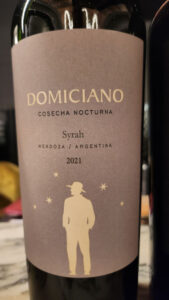 Domiciano “Cosecha Nocturna” Syrah 2021 – Syrah, or Shiraz, are they the same thing? Yes, and no. Genetically, the same grape. At some point, Syrah in Australia came to be called Shiraz – there are various proposals as to why, but chalk it up to that Australians just talk funny. Over time, it’s come to be that in general, Syrah is associated with an “old world” style, the French style epitomized by the Rhône Valley, while Shiraz is associated with the “new world”, Barossa Valley in Australia, and California. Domiciano “Cosecha Nocturna” Syrah 2021 – Syrah, or Shiraz, are they the same thing? Yes, and no. Genetically, the same grape. At some point, Syrah in Australia came to be called Shiraz – there are various proposals as to why, but chalk it up to that Australians just talk funny. Over time, it’s come to be that in general, Syrah is associated with an “old world” style, the French style epitomized by the Rhône Valley, while Shiraz is associated with the “new world”, Barossa Valley in Australia, and California.
This one would fit more into the model of what I think of as Shiraz – rich, blackberry jam, sweet oak, bittersweet chocolate. I found it to be a little “hot”, i.e., the alcohol seemed higher than it ought to be, leaving a slightly burning sensation in the aftertaste, and the tannins, the bitterness you get from grape skins (think of the sensation of having left a teabag in the cup too long) were a little too astringent for my tastes. Likely those will both resolve with another year or two of aging in the bottle, and I think this will be a quite lovely wine then, and something I’d pair with a lighter roasted meat, like chicken, duck, or pork. Sells here for around 8,000 pesos, around $6.50. |
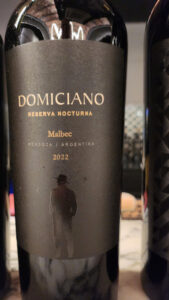 Domiciano “Reserva Nocturna” Malbec 2022 – I have to admit, I found it a little odd that the “night reserve” being offered, even from a different grape, was a year younger than the regular harvest version. If the Syrah was too young by a year or two, this is too young by probably another year beyond that. Malbec does tend to age more rapidly than Syrah, but still, this bordered on infanticide. Yes, there was the classic dark plum flavor, but muted, and currently dominated by oak, alcohol, and dry tannins. I’d stick this on the wine rack for at least two years before I’d even contemplate opening it. Domiciano “Reserva Nocturna” Malbec 2022 – I have to admit, I found it a little odd that the “night reserve” being offered, even from a different grape, was a year younger than the regular harvest version. If the Syrah was too young by a year or two, this is too young by probably another year beyond that. Malbec does tend to age more rapidly than Syrah, but still, this bordered on infanticide. Yes, there was the classic dark plum flavor, but muted, and currently dominated by oak, alcohol, and dry tannins. I’d stick this on the wine rack for at least two years before I’d even contemplate opening it.
While Argentines tend to jump to Malbec with every sort of meat, especially steaks off the grill, I’ve never found it to be a great match with that. And interestingly, until the ’80s, neither did they. Like Merlot in the US which took off because a few wine writers asserted it was easy to drink and easy to pronounce, the same thing happened here with Malbec. I generally prefer it with, again, lighter meats like birds and pork. Sells here for around 12,000 pesos, around $8.50. |
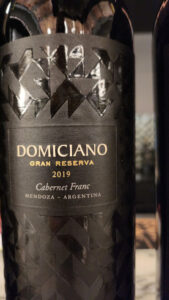 Domiciano “Gran Reserva” Cabernet Franc 2019 – Not everyone likes Cabernet Franc. It tends to come across to many people as a sort of rough version of Cabernet Sauvignon. And that’s not surprising – Cabernet Sauvignon is an intentionally bred grape that’s a cross between Cabernet Franc and Sauvignon Blanc, with the intent to tame some of those rough, brambly sort of flavors. Domiciano “Gran Reserva” Cabernet Franc 2019 – Not everyone likes Cabernet Franc. It tends to come across to many people as a sort of rough version of Cabernet Sauvignon. And that’s not surprising – Cabernet Sauvignon is an intentionally bred grape that’s a cross between Cabernet Franc and Sauvignon Blanc, with the intent to tame some of those rough, brambly sort of flavors.
Despite being five years old, this wine is still showing hallmarks of being young. That said, it’s fully drinkable now, though I think it will be better in another year or so. A mix of red fruits, tinged with graphite – pencil lead, a hint of sweet graham cracker, and a touch of that brambly character, classic for the grape. For me, a wine like this is perfect with game meats, or a rich, slightly gamey stew – here in Argentina, I’d pair it with one of the two big classic national stews – locro or carbonada. Sells here for around 30,000 pesos, around $21. |
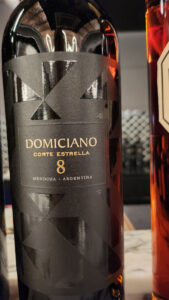 Domiciano “Corte Estrella 8” – Upfront, I love the concept. Each year, the winemakers and owners of Domiciano get together and sample through various blends of both currently fermenting wines, and those already in barrel from past years, and come up with a blend, different each time, that they bottle as this “Star Blend”. Because it’s a blend of different years, it’s a non-vintage dated wine, and this, obviously, is the eighth year they’ve done this. Domiciano “Corte Estrella 8” – Upfront, I love the concept. Each year, the winemakers and owners of Domiciano get together and sample through various blends of both currently fermenting wines, and those already in barrel from past years, and come up with a blend, different each time, that they bottle as this “Star Blend”. Because it’s a blend of different years, it’s a non-vintage dated wine, and this, obviously, is the eighth year they’ve done this.
Corte 8 is 80% Malbec and 20% Cabernet Franc. It was my favorite out of the tasting, and that’s shouldn’t be surprising given the attention to producing a blend that’s the “star” for that year. A delightful mix of red and black fruits, particularly cherries, and a hint of mint on the finish, this wine would be a great one to drink on its own, but for me, this would be the one I’d pull out with a great steak, or maybe something like a roast suckling pig! Sells here for around 38,000 pesos, around $27. |
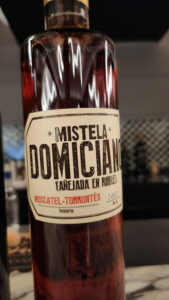 Domiciano Mistela – This is the sort of wine that people who like this sort of wine will like. For me, mistelas are just too sweet. A mistela is not fermented, so it’s not actually wine. It’s fresh grape juice to which more or less pure alcohol is added to a level (usually about 13% or more) to prevent it from fermenting. Add to that the it’s fresh grape juice from overripe grapes, that are ready to be made into a dessert wine, and this is a sticky, syrup blend of Moscatel and Torrontés that while some people might want to sip on, even Federico recommended it as part of a spritz sort of cocktail. It might have been nice to try it made into that cocktail, but as it is, it’s just not a something that I even have a recommendation for what to pair it with. Maybe almost like a vin santo, I’d dip biscotti in it. Sells here for around 12,000 pesos, around $8.50. Domiciano Mistela – This is the sort of wine that people who like this sort of wine will like. For me, mistelas are just too sweet. A mistela is not fermented, so it’s not actually wine. It’s fresh grape juice to which more or less pure alcohol is added to a level (usually about 13% or more) to prevent it from fermenting. Add to that the it’s fresh grape juice from overripe grapes, that are ready to be made into a dessert wine, and this is a sticky, syrup blend of Moscatel and Torrontés that while some people might want to sip on, even Federico recommended it as part of a spritz sort of cocktail. It might have been nice to try it made into that cocktail, but as it is, it’s just not a something that I even have a recommendation for what to pair it with. Maybe almost like a vin santo, I’d dip biscotti in it. Sells here for around 12,000 pesos, around $8.50. |
